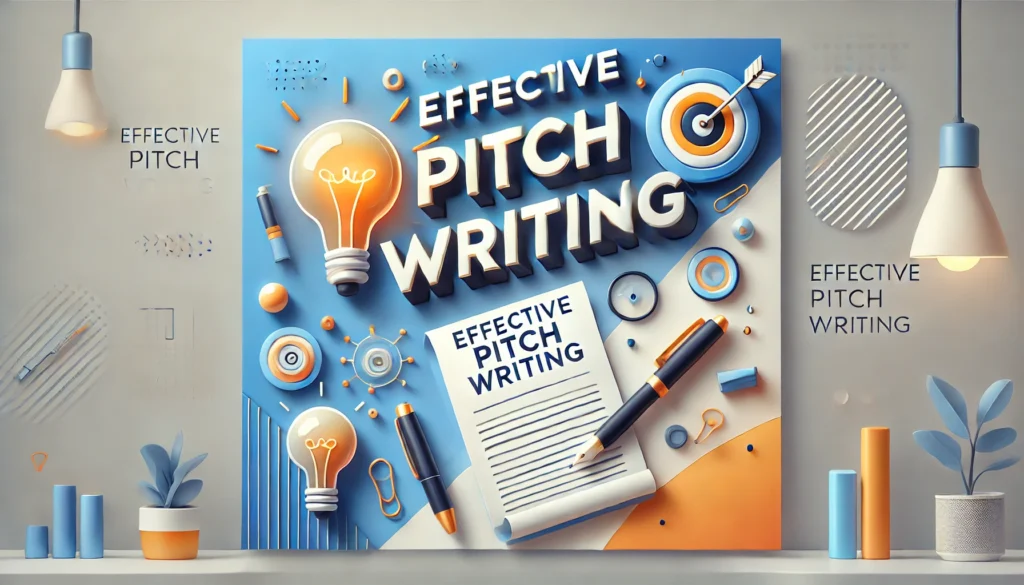When it comes to presenting your ideas, projects, or business plans, the ability to write a compelling pitch is an invaluable skill. Whether you’re addressing potential investors, clients, or collaborators, your pitch can make or break the opportunity. But what exactly makes a Effective Pitch Writing? How do you ensure it grabs attention, communicates your vision, and convinces others to say “yes”?

This blog dives deep into Effective Pitch Writing, breaking it down step by step, with easy-to-understand language and practical tips. By the end, you’ll have all the tools you need to craft pitches that resonate and deliver results.
Table of Contents
What is Effective Pitch Writing?
Effective Pitch Writing is the process of creating a clear, concise, and persuasive proposal designed to communicate your ideas, products, or services. The goal is to captivate your audience, address their needs, and inspire them to take action, whether it’s funding your project, buying your product, or collaborating with you.
At its core, an effective pitch is about storytelling. It combines facts, emotions, and a clear call to action, making it irresistible to the audience.
Why is Effective Pitch Writing Important?
- First Impressions Matter: A strong pitch can leave a lasting impression and set the tone for future interactions.
- Clarity of Message: It ensures your ideas are communicated clearly, reducing misunderstandings.
- Builds Credibility: A well-crafted pitch reflects professionalism and preparedness.
- Inspires Action: The ultimate goal is to get the audience to say “yes” – to invest, buy, or collaborate.
Steps to Master Effective Pitch Writing
1. Understand Your Audience
The foundation of Effective Pitch Writing lies in knowing who you’re speaking to.
- Research their needs: What are their goals, pain points, or challenges?
- Adapt your tone: Use language that resonates with their background and preferences.
- Highlight relevance: Show them how your idea or solution aligns with their interests.
2. Define Your Objective
Before writing, ask yourself:
- What do I want to achieve with this pitch?
- Am I looking for funding, approval, or a partnership?
A clear objective ensures your pitch remains focused and impactful.
3. Start with a Powerful Hook
The first few seconds determine whether your audience stays engaged.
- Tell a story: Begin with a real-life scenario that highlights the problem you’re solving.
- Ask a question: Pose a question that sparks curiosity.
- Share a statistic: Use a surprising fact to grab attention.
For example:
“Did you know that 60% of small businesses fail due to poor marketing strategies? We’re here to change that.”
4. Clearly Define the Problem
Every pitch must address a problem or need.
- Be specific: Clearly describe the gap or issue your audience cares about.
- Use relatable examples: This helps the audience connect emotionally.
Example:
“Small businesses often struggle to reach their audience effectively, wasting time and money on strategies that don’t work.”
5. Present Your Solution
This is the heart of your pitch. Explain how your idea, product, or service solves the problem.
- Focus on benefits: How does your solution improve lives or businesses?
- Keep it simple: Avoid jargon and stick to plain language.
Example:
“Our platform helps small businesses create targeted marketing campaigns with just a few clicks, saving time and boosting sales.”
6. Highlight Your Unique Selling Proposition (USP)
What makes your idea or product different?
- Be concise: Use one or two sentences to explain your USP.
- Showcase your edge: Highlight features or benefits competitors don’t offer.
Example:
“Unlike generic tools, our platform uses AI to analyze customer behavior, ensuring each campaign hits the mark.”
7. Provide Evidence
Back up your claims with data, testimonials, or case studies. This builds credibility.
- Use real results: Share stats or metrics that prove your solution works.
- Include testimonials: Positive feedback from clients or users adds trust.
Example:
“Our beta users saw a 35% increase in sales within three months.”
8. Keep It Concise
One of the golden rules of Effective Pitch Writing is brevity.
- Avoid unnecessary details.
- Focus on the most compelling points.
- Use short sentences and bullet points for readability.
9. End with a Clear Call to Action (CTA)
What do you want your audience to do next?
- Be direct: “Schedule a meeting,” “Sign up today,” or “Invest now.”
- Make it easy: Provide clear instructions or links.
Example:
“Let’s work together to take your business to the next level. Schedule a free demo today!”

Tips for Writing an Effective Pitch
- Use Simple Language: Avoid technical terms unless necessary.
- Focus on Benefits, Not Features: People care about how your solution helps them.
- Be Passionate: Your enthusiasm can inspire your audience.
- Proofread: Ensure your pitch is free of errors.
- Practice Delivery: If presenting verbally, rehearse until you’re confident.
Common Mistakes to Avoid
- Being Too Vague: Always be specific about your idea and its benefits.
- Overloading with Information: Keep it simple and focused.
- Ignoring the Audience’s Needs: Your pitch should address what they care about.
- Weak Closing: End with a strong and clear CTA.
Conclusion
Effective Pitch Writing is an essential skill for anyone looking to persuade, sell, or collaborate. By understanding your audience, clearly defining the problem and solution, and ending with a strong call to action, you can craft pitches that leave a lasting impact. Remember, practice and refinement are key. Keep honing your skills, and soon you’ll master the art of writing pitches that get results.
FAQs
What is the most important part of a pitch?
The opening hook is critical. It grabs the audience’s attention and sets the tone for the rest of the pitch.
How long should a pitch be?
For written pitches, aim for one to two pages. For verbal pitches, keep it under 3 minutes.
What tone should I use in a pitch?
The tone should be professional yet conversational. Adapt it to suit your audience.
How do I make my pitch stand out?
Focus on your unique selling proposition, use storytelling, and back your claims with evidence.
Can I use visuals in my pitch?
Yes, visuals like charts, graphs, and images can make your pitch more engaging and easier to understand.



